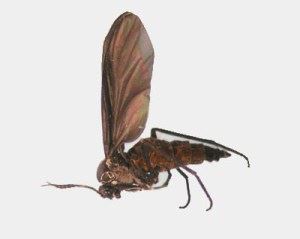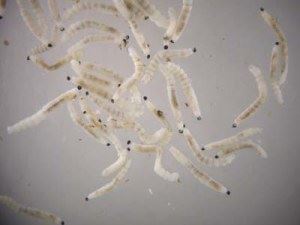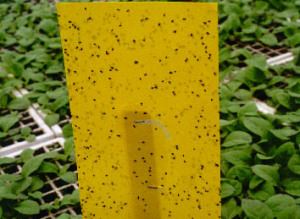Fungus Gnats And Shore Flies Can Thrive In Tobacco Float Systems
DR. LEE TOWNSEND
PRINCETON, KY.
Fungus gnats and shore flies are common greenhouse pests that also can thrive in float plant systems. The larvae of both species develop in moist to wet habitats; wet growing media also can supply their needs.
Fungus Gnats
Fungus gnats are small mosquito insects with dark wings and long antennae (Figure 1). These non-biting gnats are probably more common than shore flies because the gnats are attracted to most accumulations of wet organic matter. Natural sources include accumulations of wet dead leaves and grasses in low-lying areas.

Figure 1. Darkwinged fungus gnat.
Photos: Lee Townsend, UK
These small flies deposit groups of 20 to 30 eggs. Thin white larvae with black heads (Figure 2) live in the media, feeding as scavengers; occasionally they may prune fine plant roots but their impact on growing transplants should be minimal. The life cycle from egg to adult takes about 30 days. The adults live 7 to 10 days but do not feed or otherwise damage plants; however, large numbers can build up by late in the transplant production season.

Figure 2. Fungus gnat larvae with distinct black heads.
Shore Flies
Shore flies have stouter bodies, short thick antennae, and some distinct clear spots on a pair of smoky wings. The larvae are more maggot-like, lacking a distinct head, but with a forked tail ending in small breathing openings (spiracles). The biggest difference between fungus gnats and shore flies is that larvae of the latter develop on algal growth on the surface of wet plant media. The larvae use tiny mouth hooks to scrape up algal cells. They may tunnel into small transplants, creating weakened areas that snap off. Consequently, they are potentially more destructive than fungus gnats.
Management
• Eliminate puddles of standing water around float beds, as much as practical. These can be sources of gnats.
• Eliminate algae growth on float trays to manage shore flies. Avoid excess fertilizer.
• Monitor float systems with yellow sticky cards (Figure 3) to detect adults as they first appear. An early start in gnat management has a greater chance of success than one begun late.

Figure 3. Yellow sticky card with gnats.
• Products containing Bacillus thuringiensis israelensis (Gnatrol) can aid in controlling fungus gnat larvae, but these are not effective against shore flies. The treatment is applied as a drench according to label directions.
• Foliar sprays of insecticides containing acephate (Orthene, etc.) can kill adult fungus gnats and shore flies by direct contact but generally will not reach the larvae. These sprays do not kill the pupae of either species. ∆
DR. LEE TOWNSEND: Extension Entomologist, University of Kentucky